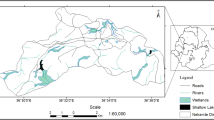Abstract
In this study, an attempt has been made to suggest crop diversification based on soil and weather requirements of different crops. State level spatial databases of various agro-physical parameters such as rainfall, soil texture, physiography and problem soil along with the agricultural area derived from remote sensing data were integrated using GIS. A raster based modelling approach was followed to arrive at suitable zones for practicing different cropping systems. The results showed that the south-western Punjab is suitable for low water requiring crops such as desi cotton, pearl millet, gram etc., where as north-eastern Punjab with high rainfall and excess drainage should practice maize based cropping system. Rice can be substituted by maize and other crops in Central Punjab, where water table is going down fast. Using this approach the area of rice based cropping system can be reduced from present 24.7 lakh ha to 19.6 lakh ha, thereby reducing the degradation of valuable land and water resources.
Similar content being viewed by others
References
Allen, R.G. and Pruitt, W.O. (1986). Rational use of the FAO Balney-Griddle formula.J. of lrr. and Drain., Engg. Div.,ASCE,112(IR2): 139–155.
Aulakh, K.S. (2002). Let us bring Punjab agriculture out of the present crisis.Progressive Farming,38: 4–5.
ESO (1995). Statistical Abstract of Punjab — (1995). Economic and Statistical Organisation. Government of Punjab.
Grewal, S.S. and Sidhu, M.S. (1990). A study on growth of Punjab agriculture. Research Report, Department of Economics and Sociology, Punjab Agricultural University, Ludhiana.
Kolar, J.S. and Butter, N.S. (2002). Diversification in farming: Options for Punjab farmers.Progressive Farming,38(3): 4–8. Panigrahy, S., Ray, S S., Sharma, P.K., Sood, A. and Patel,
L.B. (2003). Cropping system analysis of Punjab state using Remote Sensing and GIS. Scientific Report. RSAM/SAC/CS/SR/04/2003. Space Applications Centre, Ahmedabad, 62p.
Sood, A., Ray, S.S., Patel, L.B., Sharma, P.K. and Panigrahy, S. (2000). Agricultural Scenario in Punjab - with Special Reference to Cropping Pattern Changes. Scientific Note. RSAM/SAC/CS/SN/01/ 2000. Space Applications Centre, Ahmedabad.
Author information
Authors and Affiliations
Corresponding author
About this article
Cite this article
Ray, S.S., Sood, A., Das, G. et al. Use of GIS and remote sensing for crop diversification — a case study for Punjab state. J Indian Soc Remote Sens 33, 181–188 (2005). https://doi.org/10.1007/BF02990034
Received:
Revised:
Issue Date:
DOI: https://doi.org/10.1007/BF02990034




